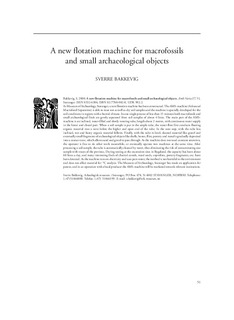| dc.description.abstract | At Museum of Archaeology, Stavanger, a new flotation machine has been constructed. The AMS-machine (Advanced
Macrofossil Separation) is able to treat wet as well as dry soil samples and the machine is specially developed for the
soil conditions in regions with a humid climate. In one single process of less than 15 minutes both macrofossils and
small archaeological finds are gently separated from soil samples of about 4 litres. The main part of the AMSmachine
is an inclined, water-filled and slowly rotating tube, length about 2 metres, with continuous water supply
in the lower and closed part. When a soil sample is put in the ample tube, the water-flow first conducts floating
organic material into a sieve below the higher and open end of the tube. In the next step, with the tube less
inclined, wet and heavy organic material follows. Finally, with the tube in level, cleaned material like gravel and
eventually small fragments of archaeological objects like shells, bones, flint, pottery and metal is gradually deposited
into a coarser sieve, which allows sand and gravel to pass through. As the machine does not need constant attention,
the operator is free to do other work meanwhile, or eventually operate two machines at the same time. After
processing a soil sample, the tube is automatically cleaned by water, thus eliminating the risk of contaminating one
sample with traces of the previous. During testing at the excavation sites in Rogaland, the capacity has been about
60 litres a day, and many interesting finds of charred cereals, weed seeds, coprolites, pottery-fragments, etc. have
been detected. As the machine runs on electricity and uses pure water, the method is not harmful to the environment
and does not affect material for 14C analysis. The Museum of Archaeology, Stavanger has made an application for
patent, and in co-operation with a local producer the AMS-machine will be marketed towards relevant institutions. | no_NO |
